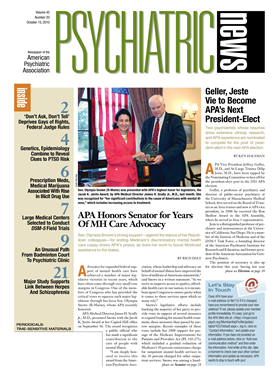Research progress on psychiatric disorders must follow the cues of cardiology and oncology, taking major steps forward to find the causes of psychopathology and develop cures for mental illness, stated the director of the National Institute of Mental Health (NIMH).
“We're in the middle of a revolution,” said Thomas Insel, M.D. “We have the chance to change the world—not tomorrow, but by staying on course.”
NIMH has laid out that course over the last few years by shifting its grants in directions that it hopes will produce “disruptive innovations,” said Insel in the inaugural lecture of the George Washington Institute for Neuroscience at George Washington University in Washington, D.C., in September.
The new institute is a multidisciplinary center that promotes research and training in the mechanisms of normal and pathological brain function.
Neuropsychiatric illnesses are the leading cause of years lost to disability or death from noncommunicable causes, noted Insel.
Progress Lags in Psychiatric Illness
Advances in research and changes in practice have cut deaths from heart disease by 63 percent since 1965, but similar progress has not happened for mental illness, he pointed out.
“We have to move the agenda,” he said. “Diagnosis still comes by observation, illness is detected late, prediction is poor, etiology is often unknown, prevention is not well developed, treatment is by trial and error, and there are no cures and no vaccines.”
Prevalence and mortality have not decreased, and the culture surrounding them is sunk in low expectations. “This is the only area of medicine where people don't talk about cure and prevention,” he said.
The burden of mental disorders is magnified by its relatively high prevalence (approximately 6 percent) and the fact that these illnesses are chronic disorders and usually begin early in life.
He suggested three main areas on which neuroscience research needs to concentrate to tackle the large public-health problem that mental illness presents: a renewed emphasis on psychiatric disorders as brain disorders, an increasing recognition of the role of child and adolescent development, and achievement of advances in understanding the genetic basis of mental illness risk factors.
Field May Shift to Clinical Neuroscience
Brain lesions may be the realm of neurology, but psychiatric illness is defined by the physiology of neural circuits in the brain, said Insel. A different approach and different training may be needed to understand and treat those illnesses. In 10 years, he suggested, psychiatry might be better termed “clinical neuroscience.”
He cited the example of Area 25 in the subgenual cingulate, a region that becomes overactive in depression, but where activity declines when depression is treated with an SSRI. Imaging studies show brain changes—but only in treatment responders. Deep brain stimulation (DBS) near Area 25 also turns down activity, he noted, and the research on DBS shows how knowledge gleaned from brain mapping, circuitry, and imaging can converge to improve understanding of disease and its treatment.
Second, mental disorders are also developmental disorders, he pointed out. Many begin before age 15, while normal brain development continues until age 25.
The cortex in patients with attention-deficit/hyperactivity disorder (ADHD) seems to take longer to mature. Individuals with the disorder “end up at the same point but two or three years late,” he said. “So is ADHD a disease of attention and behavior in children, or is it one of cortical maturation? The challenge is to see what is going wrong in the organ of interest.”
Third, while genetics are another key component of mental illness, Insel acknowledged that understanding how hundreds of variations map onto brain pathways is a complex challenge. Many variants express only in the human brain and only during development. Many other genes that contribute to mental illness have not yet been identified.
“We need to move from description to mechanism and to approach all of these problems from many levels: molecular, cellular, systemic, individual, and social,” he said.
Learning which early variations in brain structure, circuitry, and function foretell later disorder might lead to interventions that can prevent the development of frank illness.
Eventually, the foundation of brain circuitry, development, and genetics will support a better understanding of pathophysiology, prevention, and personalized medicine, all leading to Insel's goal of a comprehensive public-health approach to psychiatric disorders.
The George Washington Institute for Neuroscience has scheduled a dozen more lectures by other neuroscience researchers between now and next May.

